Peter Cawdron's Blog, page 13
October 7, 2014
DOUBLE Book Review – Revolution & My Sweet Satan
Here’s a review of two books I released this month.
 Originally posted on Will Swardstrom - Author:
Originally posted on Will Swardstrom - Author:
Today – in my first blog post in over a month (more on that later) – I’ll be giving you a DOUBLE REVIEW. That’s right – two reviews in one blog post. Good for you both books are by Australian author extraordinaire Peter Cawdron.
Cawdron has had the book My Sweet Satan on Pre-Order for about a month now and it is just releasing this week. But, while we were all waiting for that book to drop, he snuck in another short story: Revolution.
 In Revolution, Cawdron paints a picture of a world similar to our own, but with technology advanced a bit. Alexander Hopkins is getting home on a red-eye flight from Russia when that world slams into him with all the force Homeland Security can muster.
In Revolution, Cawdron paints a picture of a world similar to our own, but with technology advanced a bit. Alexander Hopkins is getting home on a red-eye flight from Russia when that world slams into him with all the force Homeland Security can muster.
The breadth of the story is short, so I’ll keep my review brief as well, but you want to catch…
View original 635 more words


September 19, 2014
Just a rock?
Rocks are wonderful. They’re true four-dimensional objects.
Technically, other than a black hole, everything has four dimensions, stretching in three dimensions and existing for some length of time in the fourth, but rocks are remarkable for their astonishing longevity. Compared to your average rock, our lives are rice-paper thin in terms of how far we stretch in time.
Our local museum has an assortment of fossil fragments on sale in the gift shop. For $20 you can purchase the fossilized tooth of megalodon, an extinct species of shark that makes the Great White look like a tadpole.

What’s that in the water beside Megalodon? Oh, it’s a toothpick!
For $15 you can snag a trilobite that’s roughly 400 million years old.
As for me, I think it’s comical that money changes hands so someone can “own” a 400 million year old fossil. The time this fossil spends in my possession is ludicrously brief relative to its age, and I can’t help but wish it another 400 million years of existence beyond the pitiful 20-30 years it spends on my shelf.
We see rocks and fossils in three dimensions, but they exist in four. If we could “see” time as we see length, these fossils would be absurdly long. If we translate time into length, and consider our entire lives as roughly a centimeter in length (about the length of your thumb nail) then that trilobite would stretch from New York to Los Angeles!
Rocks are chrononauts. They’re time travelers.
In October of 2012, Lisa Webber heard a a thump on her garage roof. Little did she know as she watched TV, but her house had just been struck by a meteorite.

Time lapse photograph of the Novoto meteorite. Picture credit: Ames Research Center
The next day, after reading about a meteor in her local paper, Lisa and several other residents became curious about those bumps in the night and found fragments of meteorite on their roofs. Far from being “just a rock” the Novoto meteorite has revealed a surprising amount of detail about the early solar system.

Not quite the same “deep impact” you see in the movies, but far more interesting. Picture Credit: SFGate
Rocks are time capsules. They’re durable, and they capture geological events like a camera takes photographs.
The details “recorded” by the Novoto meteorite, are nothing short of astonishing.
Here’s what NASA scientists have been able to determine from this tiny fragment of rock, overlaid against a brief, rough sketch of the history of life on Earth.
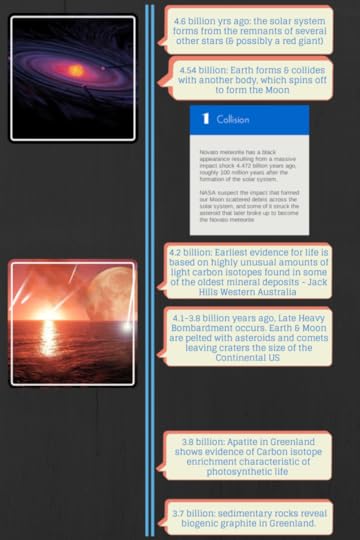




The Novato meteorite fragments are an example of how science can painstakingly retrieve information stored over billions of years to gain better insights into our universe.
Think about that next time you kick a rock down the street!


July 12, 2014
Pink elephants floating by
What’s the most absurd thing you can think of? The concept of pink elephants floating through the sky might spring to mind. The idea of large animals floating in the air is ridiculous because of the sheer weight involved, and yet have you ever considered how massive a cloud actually is?

Picture credit: Art of the Day
A cloud’s mass is spread out in a thin vapor with a density of anywhere from 1/10 of a gram per cubic meter up to 5 grams per cubic meter , but add it all up and there’s a surprising amount of mass in even something as fluffy as a common cumulus cloud.
Cumulus clouds sit roughly 2 kilometers above the ground and, on average, cover a cubic kilometer of space, with a total mass of over a billion kilograms (2.2 billion pounds). Putting this in perspective, there’s roughly 8-10,000 blue whales in the ocean, each weighing up to 160 tons, that’s the same mass as a mere 2-3 cumulus clouds!
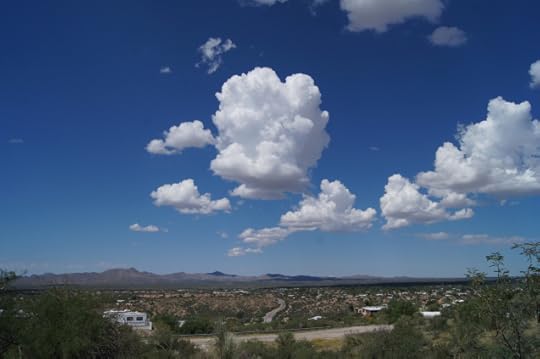
Picture credit: Cloud Maven - Cumulus clouds over the desert. Thousands of blue whales would be far more spectacular
What about a thunderhead?
What about a massive cumulonimbus rolling in over the horizon? You know, the clouds that look like something from the opening of the movie Independence Day?

Picture credit: Cumulonimbus by Pat Groove
Cumulonimbus clouds contain roughly the same mass as 10,000 747 jet airplanes or 200,000 elephants floating through the sky! What a sight that would be!
In addition to the kinetic energy of such a massive storm, there’s also a phenomenal amount of energy released as water condenses, forming the mushrooming updraft you see above. Chaotic collisions between particles within the cloud and the circular motion of air currents causes different electrically charged regions to form within the various cloud banks, leading to lightning and thunder. When all this is taken into account, it’s no surprise to learn that the average thunderstorm releases the equivalent of a 20 kiloton nuclear bomb! Most of the time, this energy is released across a broad front and does little or no damage, but when it concentrates in the form of a tornado or in the eye wall of a hurricane, the devastation is not dissimilar to that of Hiroshima and Nagasaki.
As tempting as it is to ignore weather warnings and chase storms, don’t. Remember, you wouldn’t gamble with nuclear weapons or several hundred thousand elephants raining down upon you, why take a chance on a tornado? Stay safe this tornado season.
And when it comes to a hurricane, we’re talking the equivalent mass of forty million elephants. It’s a silly measurement, that’s for sure, and we’re not likely to switch to measuring hurricanes in elephants any time soon, but it does help put the size of these storms in perspective.
Clouds…. who’d have thunk they could be so troublesome.

Picture Credit: Pink Floyd album Animals


July 5, 2014
At the top of the bell curve
I’m not sure what TV show this was from, it might have been The Office or The Big Bang Theory, but in the show one character insulted another rather obnoxious character who was protesting how smart they were. The conversation went something like…
Him: “I’m smart. I’m intelligent.”
Her: “Oh, sure, you’re right at the top of the bell curve.”
For those of you not familiar with a bell curve, it describes how the normal distribution of “things” whatever they may be, tends to cluster around the average/mean. Most “stuff” is similar, with the exceptions being far less frequent. This is true when it comes to test scores, job incomes, or even something like the natural variations in a species of animal. “Things” tend to be the same.

Sitting “at the top of the bell curve” puts you smack in the middle, the most common spot.
No one likes to think of themselves as average, and yet the majority of us are clustered right around that mean. Scott Adams has a great cartoon that plays to this concept.

Picture credit: Scott Adams
Being average isn’t so bad. We’re all average in one way or another, as there’s so many ways to measure ourselves.
I was chatting with a friend about stars and they made the point that the average distance between stars across the whole universe is about 4,000 light years, while the average within our galaxy is 4 light years or about 0.02 stars per cubic light-year, highlighting that there’s a whole lot of empty space out there between galaxies.
Look somewhere like a globular cluster or in the center of a galaxy, and the average is several stars per cubic light year. In these dense regions of a galaxy, stars are practically on top of each other, and the tremendous gravitational tidal forces produced can cause stars to be thrown out of the cluster and even out of the galaxy altogether.
The point being, if you look at all the stars in our galaxy, we’re right smack on the mean. We’re roughly the “same as others,” and that bodes well for the search for life beyond Earth.
Scientists even have a name for this, the Copernican principle, which states that Earth is not special or exceptional. We may think the Earth is, but that’s because we have a natural bias. Mediocrity might be bad in business, but in science, it is the only rational, logical assumption you can make. Out of the roughly two hundred billion stars in our galaxy, and the estimated forty billion planets surrounding those stars, Earth is probably quite mediocre. Certainly, in terms of our distance to other stars we are.
Given what we can observe, life should be quite abundant in our galaxy. Why haven’t we found life? Well, that’s a bit like asking 14th century sailors why they haven’t found the fabled Indies yet. Oh, sure, we can sail to England or to the islands of the Mediterranean, but sailing west to the Indies??? How preposterous! And yet now, of course, such a journey by sea or by plane seems quite rudimentary.
We will find life in outer space. It’s just a matter of time. How can I be so confident? Because we already know life can thrive in space. Earth is the perfect example, and Earth and her star appears to be quite mediocre.
We’re at the top of the bell curve, woo hoo!


July 3, 2014
NASA’s little secret
In 2018, NASA will launch the James Webb Space Telescope, but the James Webb is no ordinary telescope. The James Webb is set to revolutionize astronomy in a way that will eclipse even the magnificent achievements of the Hubble Space Telescope.

Picture credit: NASA. The JWST development team in front of a full-size mock up of the telescope
To understand how extraordinary the James Webb is, you have to appreciate the extremes that have gone into this marvel of scientific innovation. The James Webb will orbit almost a million miles from Earth at LaGrange point 2 some 940,000 miles (1.5 million kilometers) from Earth. That’s roughly four times the distance from Earth to the Moon. In essence, the Earth-Moon system will drag the James Webb along with it as we orbit the Sun.
For the instruments on the James Webb to function properly they have to operate at 40 Kelvin or -233C which equates to -375F . The telescope has a five-layered sunshade designed to keep the operating instruments at temperatures below the freezing point of oxygen.

Picture credit: NASA
The James Webb will be able to see back further than Hubble, back to the end of the celestial “dark age.” The JWST will see the first moment the expanding gas from the Big Bang began forming stars and galaxies.
The James Webb is going to revolutionize a field we thought was already revolutionized by the Hubble.
[The James Webb Space Telescope] has, in many ways, 100 times the capabilities that the Hubble Space Telescope does. We’re actually going to be able to see the first stars forming, the first galaxies forming after the Big Bang. We’re also going to be able to — we think — directly image planets orbiting other stars — Michael Shara, Curator in the Department of Astrophysics at the American Museum of Natural History

Picture credit: NASA
NASA has a secret, one it has hinted at indirectly, one that it has down-played, but a secret it is quietly hoping will come true.
It’s no secret NASA is looking for life, but NASA is being coy about the role of the James Webb will play in the search for life elsewhere in our universe.
Look at the goals for the mission:
To detect the first light emerging from the Big Bang
To understand the formation of galaxies
To observe the birth of stars and planets
To image planetary systems and the origins of life
Technically, the last goal is to look for “chemical precursors for life,” but that’s a rather modest way of not getting too overly excited about just what the James Webb could possibly see. As with any scientific research, there is going to be considerable effort put in to confirming any discoveries, but it is quite likely the James Webb will be able to detect the signatures of life in the atmosphere of distant planets. Validating such a finding will be the subject of innumerable research papers, I’m sure.
Here’s what Venus, Earth and Mars would look like to an instrument similar to the James Webb peering at our solar system from a distance.

Picture credit: Deep Astronomy
Finding markers for an abundance of oxygen, nitrogen, carbon dioxide and water vapor, as an example, would be a smoking gun for life similar to what we have here on Earth. Oxygen is so highly reactive it tends to get locked up in chemical sinks like rust in the soil, etc. On Earth, it took hundreds of millions of years for oxygen to be liberated by photosynthesis, and since then Earth has enjoyed recycling oxygen over and over again in the oxygen cycle. If we see a similar stable arrangement on a planet around another star, we’ll have an extremely strong candidate for life.
The James Webb Space Telescope is our best chance of finding life around distant stars.
These are exciting times.


June 8, 2014
On the edge of my seat
Regardless of his quirky beliefs, Tom Cruise knows how to pull off a blockbuster.
As an actor, Cruise has forged a career taking obscure stories to the big screen. I loved Oblivion. Sure, there were a few plot holes, but it was a gutsy and somewhat art-house take on an alien invasion, and in a time of death-by-sequel both Oblivion and Edge of Tomorrow are a breath of fresh air. Please, Mr Hollywood, no more Transformers or Godzilla remakes. Even such franchises as X-Men are past their used by date. They’re great as popcorn movies, but they’ll never be as memorable as Oblivion or the Edge of Tomorrow.
Edge of Tomorrow is a real fan-boy movie, with the mech suits deliberately reminiscent of Warhammer 40,000, a tabletop miniature set piece battle game developed in 1987. As if in honor of Warhammer, Emily Blunt even wields a battle sword against the alien horde.

Picture credit: Warhammer
Edge of Tomorrow is based on a Japanese book called All You Need Is Kill, published in 2004 by Hiroshi Sakurazaka. Originally, Brad Pitt was approached for the lead, but he turned it down. Tom Cruise loves switching between genres, appearing in such diverse movies as Top Gun, Jerry Maguire and Valkyrie. Tom jumped at the chance of more scifi.

Picture credit: Edge of Tomorrow
Edge of Tomorrow stays largely true to the essence of All You Need Is Kill, changing only locations and focusing on one portion of the book rather than trying to tackle the whole novel. There’s some key changes around the ability to go back in time and the means of defeating the mimics, but these strengthen rather than lessen the movie adaptation. Warner Bros are to be commended for taking a chance on Edge of Tomorrow, and its success bodes well for original movies in the future.
Edge of Tomorrow deliberately sets the alien invasion in a World War II style setting. Cruise trains in Forward Operating Base Heathrow on the eve of D-Day with his troops assaulting the shallow beaches of Normandy to establish a foothold in Fortress Europe. The visuals are spectacular, the story line intense, and the aliens are given a level of intelligence and sophistication beyond the normal raging bull stereotype.
Edge of Tomorrow works well in 3D. For large portions of the movie, 3D isn’t needed, and that has you forget you’re wearing 3D glasses until something comes flying out of the screen and you duck! It was nice to see 3D used with judicious precision like this.
There were a few insane battle scenes that felt a little too much like watching a video game, but these didn’t last long and were interspersed with touches of humanity as we see Cruise go from coward to hero to disillusioned wash-up and on to a hard won victory. Yes, it’s Groundhog Day for science fiction junkies, but Edge of Tomorrow is a must to see on the big screen.
Fives stars from me.

Picture credit: IMDB


May 29, 2014
Ancient Aliens???
NASA recently released a free ebook called Archaeology, Anthropology and Interstellar Communication only to remove it because of an errant reference to the possibility that Earth was visited by aliens in ancient times.
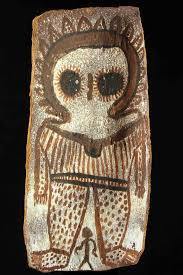
Picture credit: Aboriginal Art
So what’s the deal?
Could aliens have visited Earth in the remote past?
Theoretically, yes, but the problem is there’s no evidence for this idea.
We’ve all seen pictures of cave paintings depicting people pointing at stars or stick figures of seemingly alien-esque creatures on cliff walls, but is there any merit in this concept? I’d argue the answer is no.
If you look at any scientific theory you’ll find there are always multiple lines of independent evidence converging on a conclusion.
Evolution, for example, isn’t proven by fossils. Evolution is demonstrated by a number of different disciplines from molecular genetics to the history of agriculture and the artificial selection of plants and animals. Fossils provide us with a wonderful means of understanding extinct life, but they’re secondary evidence for evolution. You can look at geology and biology and arrive at the same conclusion about the sequence in which life arose on Earth. Every independent line of investigation we examine leads us to the same conclusion: life evolved naturally on Earth over billions of years.
When it comes to ancient aliens, there’s a dearth of evidence. All we have are some poorly interpreted cave paintings to speculate about, and speculation isn’t science.

Picture credit: The movie Prometheus even went so far as to depict an ancient alien as an ancient priest just to make sure no one missed the point
So if Earth was visited by aliens in ancient times, what would we expect to see?
Here are a few ideas.
Disruption
Think about the impact of the Spanish on Aztec society, or the arrival of Europeans everywhere from Africa to India, America to Australia. None of these societies remained intact. They all suffered from the intrusion of terrestrial aliens, and sometimes in entirely unforeseeable ways, like the introduction of European diseases. There were cultural changes, linguistic changes, habitat changes, lifestyle changes, religious changes.
The arrival of an advanced alien civilization at any point in the last 100,000 years would have had a massive impact on human society, and that would be measurable today in the artifacts and habitats these people left behind.

Picture credit: Aliens vs Predators
Disruption need not be negative. There are plenty of examples of positive disruption, like when the iPhone or the iPad entered the computer market. Traditional desktop computers and even laptops found themselves outmoded and sales dropped. In the same way, some have suggested that the pyramids and Stonehenge were built with the assistance of ET, but there’s a flaw in this argument. There’s no sign of construction techniques or tool markings that are inconsistent with the low level of technology available in that day.
We don’t see any negative, destructive disruption, like the conquistadors arriving in South America. We also don’t see any positive, constructive disruption, like the use of a diamond-toothed saw or some super fangled laser cutting these stones. We see technology consistent with those societies producing these marvelous monuments.
Physical Presence
Although an alien building on Earth could erode over time, there are plenty of archaeological remains that have lasted for thousands of years (the pyramids, the sphinx, etc) and some that have lasted tens of thousands of years (burial pits, fire pits, stone axes, etc), but we don’t find anything out of place. There are no huge, perfectly circular indentations from the landing pads of a massive UFO weighing thousands of tons, and yet there are plenty of indentations from prehistoric village life.

Picture credit: Knowth Ireland is estimated at almost five thousand years old
There’s sooo much to explore on Earth, so many different ecosystems and an astonishing degree of biodiversity. We still haven’t scratched the surface of the sheer number of species that call Earth home. With some estimates sitting at a hundred million different species, ET would have his hands full exploring Earth. He’d be here for a while, and just as our aircraft leave tell-tale signs of jet fuel contaminant trapped in the ice of Antarctica for the next few million years, ET would invariably leave some trace signature that would be distinguishable from natural processes.
Some of our most interesting animals are found miles below the surface of the planet. If ET was conducting a biological survey (a rather likely scenario), he’d surely explore those depths, leaving a clear sign of his presence: tunnels.
When Europeans first discovered the exotic flora and fauna of Australia, they didn’t stop with a single visit. They colonized. In the same way, it is reasonable to assume any visitor from the stars wouldn’t be satisfied with a single visit to Earth. Repeat visits, by aliens with different motives and intentions, would leave more and more evidence.
And life expands. If ET was here for any length of time, he’d have baby ETs. Sounds silly, I know, but it’s a legitimate point. From the perspective of a physicist, life is expensive. Life is outlandishly extravagant and often wasteful (the sunlight-to-biomass efficiency of photosynthesis for a typical plant is less than 1%). Life requires mineral resources and energy, and harvesting these for even a temporary colony would leave tell-tale signs, like a nice big quarry in the middle of the desert or something.
And our extraterrestrial visitors have no reason to leave. From observing the history of life on Earth and the marvel of evolution, we know the value of observations made over time. Rather than simply taking a snapshot of life on Earth, any advanced civilization capable of reaching Earth would want to document how life continues to evolve on this tiny planet.
Homo sapiens have only been around for a million or so years, just a fleeting moment in evolutionary time. Civilization is a blip compared to the grand history of 3.8 billion years in which life has flourished on this planet. ET wouldn’t bother hiding from a pack of Johnny-come-lately upstarts. He’d be too busy looking at the big picture.
Celestial Presence
As we’re dealing with the possibility of intelligent aliens discovering life on Earth, we should consider their response to such a discovery.
Life in our solar system is rare. Life in the universe seems incredibly rare. Any advanced space-faring race that discovered Earth is likely to have stuck around for a while. You don’t cross thousands of light years for a day trip. So how would an alien species from the stars conduct a biodiversity study of Earth? If our intrepid aliens were following some kind of Prime Directive, they’d set up shop on the lunar surface as it’s perfect for the observation of Earth.

Picture credit: 2001 A Space Odyssey
Arthur C. Clarke struck on this with 2001: A Space Odyssey, and the presence of an alien monolith on the Moon. The Moon is an ideal spot to conduct a scientific investigation of Earth. It’s close and yet it is completely isolated. There’s an abundance of mineral resources, plenty of solar power, etc. Compared to a trip between stars, it’s next door. It’s an ideal staging point for ET.
From our perspective, the Moon is a pristine, untouched environment, and one that preserves any interruption for hundreds of millions of years. If ET had set up shop at any point in the last billion or so years, we’d know.
Another point is that distant orbits are particularly long-lived (the Moon’s been in orbit for 4.5 billion years). Any alien satellite providing communication or surveying the planet could still be sitting in a geostationary orbit or at a Lagrange point. That’s where we’d put them, but there’s nothing there.
The absence of evidence isn’t evidence of absence, but it should give us pause to think. The challenge of not leaving “footprints” is absurdly difficult, and not something an alien species would go out of their way to do, particularly if they were observing from the lifeless platform of the Moon.
Earth Probably Isn’t Friendly to ET
We think Earth is pretty swell, but for an alien adapted to a different atmosphere content, at different atmospheric pressure and different gravity, Earth could seem as hostile as Mars or Titan does to us. Getting around in such an environment would take some kind of spacesuit, making exploration cumbersome and possibly error prone.
Earth has nasty weather, volcanoes, tornadoes, hurricanes, earthquakes, sandstorms. If ET was around for a few decades, something that is entirely plausible given the distance involved in getting here and the work involved in exploring the planet, there’s a good chance he would run into environmental problems and perhaps crash or lose equipment or damage his ship, etc. ET would have plenty of opportunity to leave signs we could later detect.
Have you ever gone for a walk in a virgin forest? Even in an “untouched” forest, we walk on paths carved into the terrain. Our idea of getting out in nature is generally quite tame, and not very natural at all. In the same way as we shape nature to suit ourselves, we would expect to find similar imprints from an extraterrestrial visitor. Perhaps they’d build a visitor’s center at the entrance to their wilderness experience or something, they’d leave some kind of imprint.
Shadow Biosphere
One of the very real problems we face in exploring our own solar system is the microbial world. For all our efforts to the contrary, we can’t help but take Earth microbes to Mars.
In the same way that Europeans inadvertently brought smallpox to the New World, aliens would bring their microbiome to Earth and would invariably take some of our microbiome with them. Don’t underestimate the tenacity of microbes, H.G. Wells certainly didn’t in War of the Worlds.
Any alien life taking hold here would show up on our radar as a significant departure from the phylogenetic tree of life.
The movie Prometheus played on this idea, with “engineer” aliens altering the DNA of life on Earth and advancing evolution. If this had happened, we’d see evidence of such tampering in the genetic code that defines Homo Sapiens. Instead, we see humanity as just one tiny branch on the evolutionary tree of life.
In the image below, we’re near the (arbitrary) border between pink (representing eukaryotes) and purple (representing bacteria).

Picture credit: Interactive Tree of Life
With millions of species in the tree of life, even this marvelous image covers just a fraction of the relationships between species. How good are your eyes when you squint? From right-to-left at that junction, we have Pan troglodytes (chimps), Homo sapiens (us) and rattus norvegicus (you guessed it, rats).
Conclusion
As fascinating as it is to consider the possibility that Earth has been or is being visited by extraterrestrials, there is no supporting evidence, and certainly no convergence of consistent evidence, but don’t despair, organisations like SETI won’t rest until they find intelligent life that originated beyond Earth.

Picture credit: SETI


May 27, 2014
Vive la Indie Revolution
Over the past few years there’s been a revolution in self-published novels, and it’s far from complete, but it’s healthy and vibrant thanks to Amazon.
Like Hewlett-Packard, Microsoft & Apple, Amazon started in a garage before growing into a multi-national corporation with a staggering US$74 billion dollar turnover in 2013.
Like any large corporation, Amazon has had a checkered past, with claims of tax avoidance in the UK and allegations of poor working conditions in its numerous warehouses.
You can’t accuse Amazon of being a wallflower. It’s an organization with clear goals and aggressive drive, learning from its mistakes and pioneering new markets, such as independent publishing.
Call me naive, but I think Amazon is an intelligent, progressive organisation. Ah, I can hear the cynics already crying, “Amazon’s only after one thing, shareholder profit.” Maybe. Maybe not.
In 1970, Milton Friedman popularized the notion that companies exist for the sole reason of making profit. Even on the surface, such a position is clearly flawed as it says the only moral in business is money. Certainly, there have been plenty of examples of this, from the Wolf of Wall Street to the infamous example of GM pennypinching on the safety of the Corvair, but that doesn’t make it a correct assertion. Hollywood popularized this notion with the idea that greed is good, and in recent years we’ve seen the rise of the Occupy movement to try to curb this destructive notion.
Friedman’s comment has been called “The dumbest idea in history.”
In reality, the only reason for a company to exist is to serve the customer. For all the criticisms of Amazon, this is one area in which everyone agrees Amazon excels. Amazon puts the customer first.
And this is where things get interesting…
Amazon started as a company specializing in distributing CDs, books, software, etc, and it never lost sight of its role as a book broker. When Sony produced the first eReader in 2004, Amazon saw an opportunity and came out with the Kindle in 2007.
At the same time, Amazon launched KDP – Kindle Digital Publishing and began a journey of transforming independent publishing from a vanity press to a legitimate platform for all authors worldwide.
Why Kindle Will Change the World
A decade ago, Amazon was considered little more than a virtual version of Barnes & Noble. Now that it’s arming writers with the tools to put their work on those virtual shelves, it’s about more than just stocking a virtual superstore with best-sellers… Kindle owners aren’t cradling dinosaurs. They’re cradling tigers.

Kindle (Gen 1)
Amazon launched the Kindle knowing they were launching a revolution in publishing.
Even in its infancy, KDP had a clear vision of liberating writers, and that’s quite profound. The Amazon Kindle was never about replicating the existing book market in an electronic format. From its inception, it was about transforming the literary world by freeing writers from the shackles of a few great publishing houses. Kindle and KDP have always focused on opening the door to new voices.
Publishing houses have traditionally been the gatekeepers of books, but that’s changing. Now the gatekeeper is the reader, and that’s a remarkable transformation.
Amazon’s focus on the customer has taken publishing in an unexpected direction, giving writers their independence.
Critics point out that publishers act as the gatekeeper on quality, but readers can do that better than any publisher. Sure, there are a few bad apples that game the review system on Amazon, but you can download a free sample if you’re suspicious, or you can get a refund within a week. And fake reviews invariably backfire, as real readers will object and ensure their voice is heard.
There is a role for publishers, but it’s not to be the gatekeeper as that invariably leds to a narrow focus on what publishers think is marketable, and it’s not necessarily what writers and readers want to explore.
I’m an example of an author that has thrived as an indie. I’ve got eight books and a bunch of novellas. I’ve sold 40,000 copies, and yet publishers and agents still turn me away. Go figure!
Xenophobia – Couldn’t put the book down until my kindle battery discharged
Anomaly – One of the best books I’ve ever read
Little Green Men – Peter Cawdron has limitless imagination. When you read this book it transports you to a whole different world
And publishers claim they’re the gatekeepers? Really? These readers, and hundreds more, all disagree.
Without Amazon, I wouldn’t be a published author. Yes, that’s right, I have the audacity to claim equality with any other published author, be that independently published or through a publishing house. There is no difference.
Writers need to be published to grow. Without the feedback mechanism of readers reviewing and critiquing their work, it is impossible to develop as a writer.
Recently, I made the decision to make my top four books exclusive on Amazon at a time when other authors are telling me I should be with Kobo, Google Play, Apple, etc. Why? Because I appreciate what Amazon has done for me personally. Yes, others are coming to the party, but Amazon treats me like Neil Gaiman. Amazon gives me access to the exact same platform as Hugh Howey or Stephen King. Amazon doesn’t care if I sell one book or one million. I still have books with Smashwords, and they too are the author’s friend, but Amazon continues to champion the indie cause.
At some point, I hope to be picked up by a traditional publisher (although I’m probably not helping my cause with this blog post), but I’ll always have a soft spot for Amazon. When others were cheerleaders standing on the sidelines, Amazon was in the game with me, helping me to succeed.
Say what you will about Amazon, but without them, the indie revolution would be dead and my writing would be stuffed away in a desk drawer.
Thanks Jeff & team.

Picture credit: Hippolyte Delaroche, The Conquerors of the Bastille, 1839


May 11, 2014
Flatworms are anything but boring
Cut the head off and it grows back!
Slice the brain in two and both halves regrow, sharing past memories!
Run this creature through a mincer and, given time, a single organism becomes a horde of several hundred!
No, this is not the Borg from Star Trek or a blurb for a slasher zombie movie or some mutant from the scifi movie X-Men, this is the remarkable world of planarian flatworms.

Picture credit: Max Delbrück Center. Worms? Really? This is a post about worms??? Yes!
Flatworms are unassuming creatures, seemingly insignificant in grand scheme of life on Earth, and yet they could hold the key to the future of regenerative medicine.
Look at a giraffe, a snake, a blue whale and a planarian worm, and it’s tempting to see entirely different, apparently unrelated animals. The truth is, they’re all powered by exactly the same engine at a cellular level: DNA.
In our day, Charles Darwin’s insight into Natural Selection and the Tree of Life has been confirmed by genetics. Not only has all of life descended from the same common ancestor billions of years ago, all of life shares the same basic mechanism for life.
The difference between a giraffe and a blue whale is not found in the length of their necks, or in the difference between fins and hooves, it’s found in the subtle arrangement of four different types of nucleobases in a single molecule, DNA. OK, this might be a little over simplistic in that there’s 3.3 x 10^9 base pairs in human DNA alone, but rearrange the nucleobases of a giraffe and technically you could come up with a blue whale.
Don’t let the term nucleobase fool you with an illusion of complexity, these are basic molecules, the chemical equivalent of lego blocks. In some cases, they have as few as nine atoms. And we’re not talking about exotic atoms like Polonium or Promethium being found in a nucleobase, there’s just the regular, old, garden varieties of Hydrogen, Oxygen, Nitrogen and Carbon.
Lego is a great analogy for DNA.

Lego. Go on, you know you want to build something.
Rearrange the Lego used to build a toy house and you can build something entirely different, a toy car or a toy plane, all using the same pieces of Lego. In principle, the same is true of DNA.
The only difference when it comes to DNA is that DNA is the instruction set for how cells build the proteins that slowly support the increasing complexity that forms giraffes, blue whales, and planarians through a process not dissimilar to a Rube Goldberg machine.

Rube Goldberg “machines” use a complex series of interactions working flawlessly together to produce a certain result
Cellular life is astonishingly complex and multifaceted. Extending our Rube Goldberg analogy, DNA is the line of dominoes that topples a plastic cup, that knocks over a deck of cards, that releases a marble, that rolls down a spiral ramp and… you get the idea, only the cellular pathways that give rise to complex life occur millions of times a day inside every organism, from giraffes to snakes, blue whales to planarians, and even humble old Homo sapiens.
Why are planarians on the verge of revolutionizing regenerative medicine?
Because planarians are unique in being at the crossroads of two entirely different strategies for life. Planarians are complex animals, and yet they have the regenerative flexibility we see in the microbial world.
In the microbial world, slicing and dicing has no effect on an organism. Cells can live and divide indefinitely. In the macro world of multicellular animals we have specialized organs — hearts, lungs, eyes, brains, spinal cords and so on. These are far less robust.
Somewhere in our evolutionary history, multicellular animals traded the flexibility of the microbial world for the complexity of large-scale life, only planarians didn’t get the memo. Planarians have the best of both worlds.

Picture credit: youtube She looks quite calm considering what’s about to happen
Imagine cutting a human in half at the waist. Well, perhaps you don’t want to contemplate that outside of a magic trick as the implications are dire. Saw someone in half and they’ll undergo major trauma and die. A planarian, on the other hand, will regrow into two or more separate flatworms!
It’s as though our failed magic trick resulted in the legs growing a new trunk, arms and head, while the trunk grows a new set of legs, leaving us with two lovely assistants rather than one—twins!

Picture credit: Pearson Lab. Note the eyes growing in the midsection on day seven.
Planarians accomplish this better-than-a-magic-trick using roughly the same genetic coding we have. We share about half our genes with planarians. They have a different number of chromosomes, but look close enough and you’ll see they have the same basic body plan we have, and the same chemistry at a cellular level. Planarians accomplish their “magic” using the same four nucleobases we see shared in the DNA of all life.
Many planaria genes resemble those of humans, and also many genes specifically linked to planarian stem cell biology and regeneration are conserved in humans
In theory, there’s no reason we couldn’t do the same thing if we could tap into the same mechanism at a cellular level, and that’s what makes planarians so fascinating.
Remember Jeeves from the science fiction movie Men in Black?

Picture credit: MIB-wikia Apparently, regrowing your head hurts
Jeeves was a human-looking alien with remarkable regenerative abilities.
The MIBs blow his head clean off his shoulders several times over the course of two movies, only to see it grow back in seconds. Jeeves complains, but is otherwise entirely normal. Well, as normal as an alien living undercover on Earth can be.

Picture credit: LiveScience
Planarians aren’t quite as quick, but they can pull off this trick with aplomb, as this image shows. Here, the head is severed completely, and yet regrows. It begins rewiring the neural pathways, developing new eyes, etc. And just like Jeeves, the resulting reformed planarian is entirely normal.

Picture credit: iTOL Phylogenetic maps genetic relationships between organisms
Physically, we might look vastly different from flatworms, but genetically we’re remarkably close. If you look at the entire Tree of Life, you’ll see humans (red) and flatworms (blue) are in the same basic region, sharing a surprisingly close common ancestor (green) when compared to the vast majority of life on Earth.
The hope is that human adult stem cells can one day be coaxed into the same astonishing proficiency we see in planarian flatworms, and not just from the perspective of replacing lost limbs but in terms of treating organ damage, spinal injury and aging.
Planarians rock!
Further reading:
LiveScience
Max Delbrück Center
DevBio
BaldScientist
The First Brain


April 9, 2014
A tourist on Mars
Recently, I got to visit the Grand Canyon by helicopter.

Dawn helicopter flight
Standing there in the waiting room, watching the sun rise with a fleet of helicopters being prepped in the early dawn light, I couldn’t help but think of how astonishing such a sight would have been for García López de Cárdenas, the first European to stumble across the canyon.

North rim
The Grand Canyon is 277 miles long with an average width of anywhere up to 18 miles and a depth of just over a mile. García tried to descend into the canyon to reach the river, but failed.
If you’d told García that one day people would fly in tiny bubbles propelled by a giant fan, he would have thought you were mad. If you’d told him they’d fly down and land by the river only to have a quick wander around and a glass of champagne, he would have thought you were away with the fairies, and yet that’s precisely what happens today.
Just as there’s tourism in the Grand Canyon, one day there will be tourism on Mars.
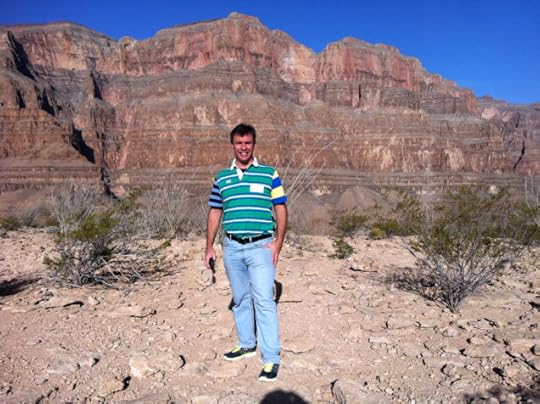
OK, on Mars I’d be wearing a spacesuit.
Behind me is a billion years of geological history, with layer upon layer burying the past, until around 10 million years ago the Colorado river began eroding the canyon. The Grand Canyon is a time capsule, allowing us to understand the progression of life on Earth and the various climates and conditions that prevailed in different epochs.
This is precisely the kind of formation NASA Curiosity Rover is exploring on Mars.
The ground around me is strewn with the most unusual rocks. At first, I wasn’t sure if they were igneous (volcanic) in origin. Although they look like pumice, they were much heavier and far sturdier. Knowing this particular layer was once an ancient sea I wondered if they were sedimentary, perhaps even some fossilized remnants of sponges or corals (which are common in the American Southwest). Then I found this beautiful rock that captures the transition from one layer to another, effectively ruling out volcanic origins.

Transition rock
The depth within the canyon would suggest this is precambrian (>500 million years), and it may well be the fossilized remains of ancient algae mats. If anyone’s a geologist and can shed some light on this, please leave a comment below.
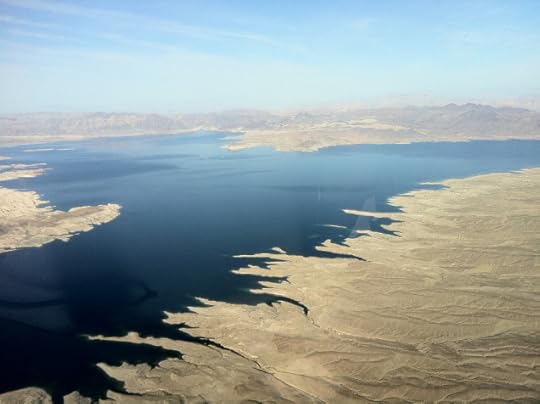
Blue Mars?
Kim Stanley Robinson wrote an astonishing trilogy about the colonisation of Mars called Red Mars, Green Mars, Blue Mars. Here’s a photo that with a reddish filter could pass for Blue Mars.
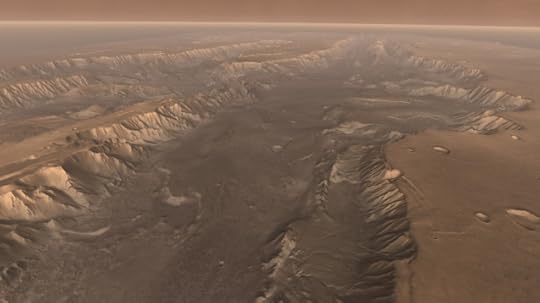
Valles Marineris
The irony of tourism on Mars is that the Valles Marineris is not only the largest canyon in the solar system, being as long as the Continental US, it’s also so wide that the curvature of the planet comes into effect. Stand on one side of the canyon at its broadest and the far side is hidden below the horizon.
One day, we’ll have tourism on the Moon, visiting the carefully preserved Apollo sites, and eventually the canyons of Mars will be tourist destinations as well, although hopefully without the trappings of Las Vegas.






